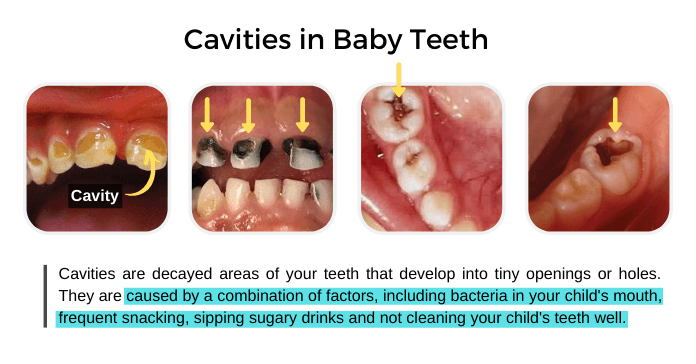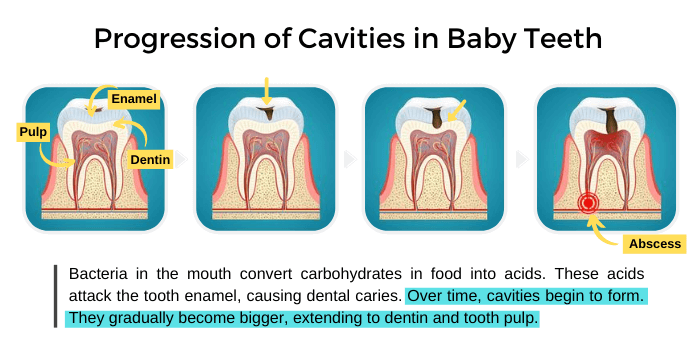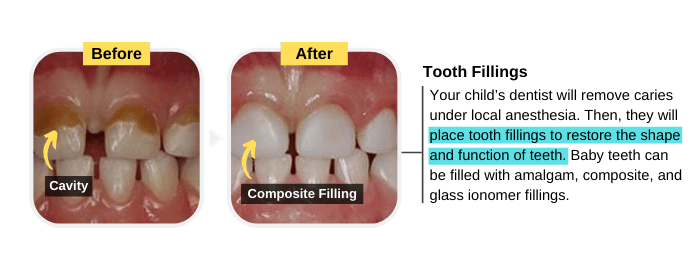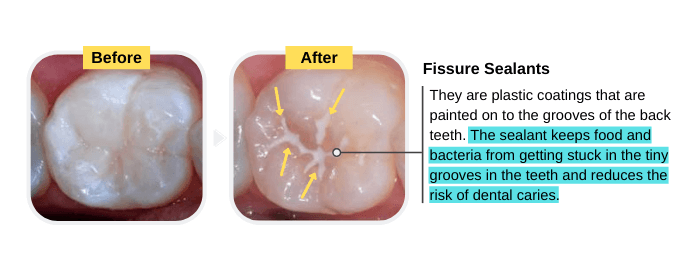Baby teeth, also known as primary teeth and milk teeth, are the first set of teeth that your child develops. The risk of cavities in baby teeth starts with the eruption of the first tooth, which occurs at the age of 6 months. The eruption of primary teeth continues until 25 -33 months. The primary dentition usually consists of 20 baby teeth.
If you don’t clean your child’s teeth well, bacteria in the mouth will feed on carbohydrates and produce acids. These acids will cause the breakdown of tooth enamel, forming holes or tiny openings in baby teeth. These holes are known as cavities, which start small and gradually become bigger. If you noticed brown or black holes in your child’s teeth, visit a pediatric dentist. They will provide a suitable treatment, which includes tooth filling, pulpotomy, pulpectomy, dental crowns, and tooth extraction.
Signs & Symptoms of Cavities in Baby Teeth
The signs and symptoms of cavities in baby teeth depend on the size of the holes and their proximity to the tooth nerve. During the early stages, your child may not feel any pain or sensitivity at all. As cavities in baby teeth advance, the holes gradually become bigger and may reach the tooth nerve (pulp), causing pain and dental abscess. The signs and symptoms include:
- Brown or black holes in baby teeth.
- Pain with biting or chewing.
- Food particles get stuck between teeth.
- Sensitivity to hot, cold, or sweet.
- Continuous pain.
- Gum swelling and pus discharge.
- Facial swelling

Causes of Cavities in Baby Teeth
Cavities are permanent damage to the tooth. They usually appear as brown or black holes in baby teeth. Bacteria in the mouth convert carbohydrates in food (glucose, fructose, and sucrose) into acids. These acids attack the tooth enamel (outer layer of the tooth) and cause the loss of tooth minerals (demineralization). Over time, acids dissolve the enamel, forming cavities. These cavities start small and gradually become bigger.
Risk Factors
Factors that increase the risk of cavities in baby teeth include:
- Accumulation of plaque on teeth surfaces: plaque is a sticky, colorless substance that adheres to the tooth surfaces. It consists of bacteria and food debris. Dental plaque can give rise to cavities in baby teeth.
- Consumption of sugary foods and drinks: Bacteria in the mouth feed on the sugar you eat and produce acids that dissolve the tooth enamel. The more sugary food your child eats, the higher the risk of cavities. Avoid sugary foods and drinks such as candy, cookies, cake, soda, and fruit juice.
- Bedtime infant feeding: giving your baby a bedtime bottle filled with milk, formula, or juice increases the risk of cavities. Because these beverages remain in the baby mouth for hours while they sleep, providing a sugar-rich environment for bacteria.
- Dry mouth: saliva helps prevent dental caries. because it washes away food debris and counters the acid produced by bacteria. Dry mouth is usually a temporary condition that occurs as a result of dehydration or mouth breathing. If the condition is persistent, visit your child’s doctor.

Diagnosis
The dentist can spot cavities in baby teeth during a regular check-up. Methods of diagnosis include:
- Oral examination: the dentist will use a mirror and probe to examine your child’s mouth and teeth.
- X-ray: the dentist will use x-rays (periapical and panoramic x-rays) to check cavities in baby teeth and the sequence of permanent teeth eruption.
Complications
Untreated cavities in baby teeth can cause complications such as:
- Ongoing tooth pain.
- Dental abscess and facial swelling.
- Tooth fracture or loss.
- Nutrition problems as a result of tooth loss.
- Permanent teeth misalignment. Because baby teeth preserve the position of permanent teeth.
Treatment of Cavities in Baby Teeth
The treatment depends on the size and location of the damage. The treatment of cavities in baby teeth include:
- Tooth fillings: first, your child’s dentist will remove caries in baby teeth under local anesthesia. Then, they will place the tooth fillings to restore the shape and function of teeth. Types of tooth fillings used:
- Amalgam fillings (silver-colored): they are strong and can withstand chewing force. However, they are unaesthetic. So, they can be suitable for posterior baby teeth.
- Composite and glass ionomer fillings (tooth-colored): they are aesthetic fillings. Tooth-colored fillings mimic the natural color of the teeth. So, they can be used in anterior and posterior teeth.
- Pulpotomy: it is a procedure that involves the partial removal of a baby tooth pulp. The pulp tissues in the crown are removed, and the pulp tissues in the root are left intact. The dentist may perform pulpotomy if the pulp tissues are still vital.
- Pulpectomy: it is a procedure that involves the complete removal of a baby tooth pulp (from both crown and roots). The dentist may perform pulpectomy if the pulp tissues are not vital.
- Dental crowns: your child’s dentist may recommend a dental crown after the pulpotomy or pulpectomy to protect the tooth and restore the shape and function.
- Tooth Extraction: your child’s dentist may suggest the removal of the baby tooth if it is severely damaged. After the extraction, the child may need a space maintainer to guide the unerupted tooth into a proper position.

Prevention of Cavities in Baby Teeth
Good oral hygiene can help your child avoid cavities. Here are some tips to help prevent cavities in baby teeth:
- Regular tooth brushing: brush your child’s baby teeth regularly at least twice a day with a soft-bristled toothbrush. If plaque is not washed away, cavities in baby teeth may start to form.
- Fluoride toothpaste: fluoride helps prevent dental caries. It also can reverse the early stage of dental caries (remineralization). The American Dental Association recommends the use of a smear of fluoride toothpaste for children under age 3 years and a pea-sized amount for children aged 3 to 6 years.
- Fissure sealant: it is a protective plastic coating, which is placed over the grooves and fissures of posterior teeth. It helps keep food and bacteria from getting into the tiny grooves in the teeth and thereby reduces the risk of dental caries.
- Healthy, balanced diet: vegetables and fruits increase saliva flow and help wash away food particles. Also, limit sugary foods and drinks and avoid foods that get stuck on baby teeth for a long time.
- Regular dental check-up: visit your child’s dentist at least once every 6 months for a regular check-up and professional cleaning.

FAQ
Yes, because baby teeth play an important role in your child’s speaking and eating. Also, baby teeth preserve the place of future permanent teeth. So, their loss can lead to nutrition problems and permanent teeth misalignment.
Untreated cavities in baby teeth can cause complications such as a dental abscess. The infection may spread to the unerupted permanent teeth, which is still in the development period. The spread of infection can lead to problems such as delayed eruption, discoloration, and malformation of permanent teeth. Also, early baby teeth loss can lead to permanent teeth misalignment because baby teeth preserve the place of future permanent teeth.
Untreated cavities can cause continuous pain, dental abscess, difficulty chewing, nutrition problems, and tooth loss. Also, early baby teeth loss can cause orthodontic problems in the future.
First, your child’s dentist will remove caries under local anesthesia. Then, they may place tooth fillings such as amalgam, composite, or glass ionomer to restore the shape and function of the teeth. If cavities reached the tooth pulp, your child’s dentist may recommend pulpotomy, pulpectomy, or tooth extraction, depending on the condition of the tooth.
Summary
- Baby teeth are the first set of teeth that your child develops.
- The risk of cavities in baby teeth begins with the eruption of the first tooth, which occurs at the age of 6 months.
- Bacteria feed on carbohydrates and produce acid that destroys the tooth enamel.
- Cavities usually appear as brown or black holes in teeth.
- The treatment of cavities in baby teeth include tooth fillings, pulpotomy/pulpectomy, crowns, and tooth extraction.
- Clean your child’s teeth regularly with a soft-bristled toothbrush and fluoride toothpaste.
- The ADA recommends the use of a pea-sized amount of fluoride toothpaste for children aged 3 to 6 years.